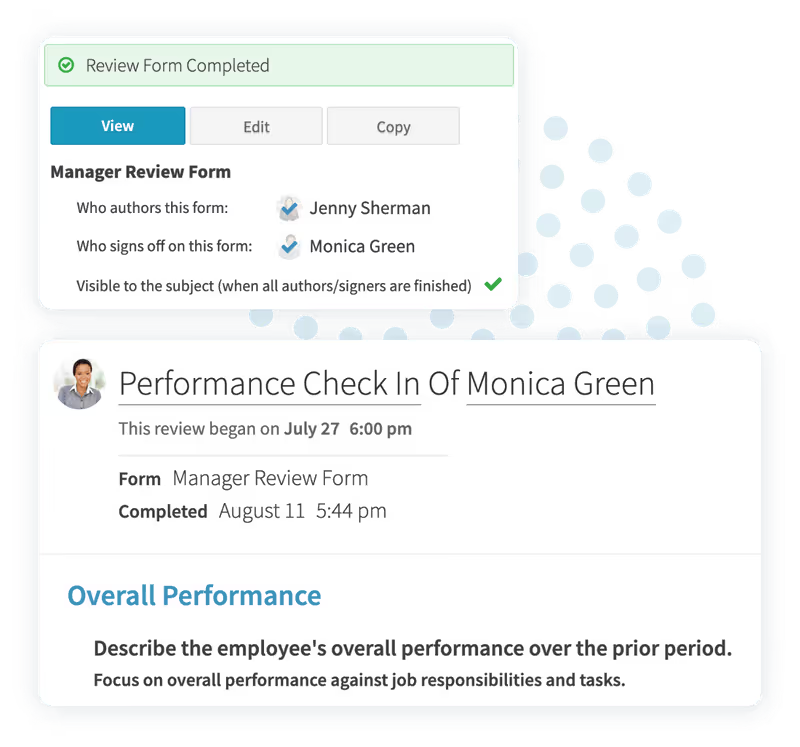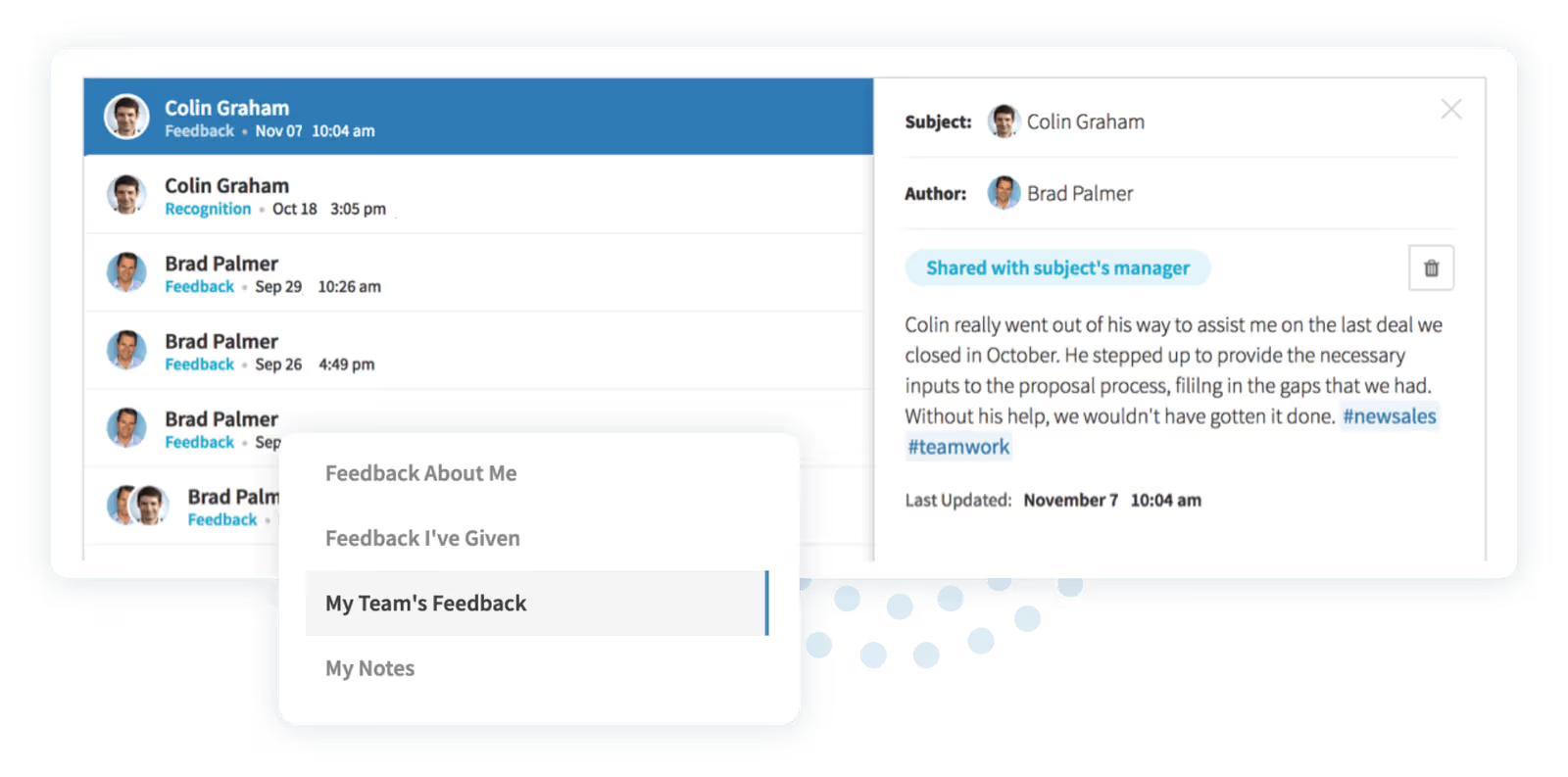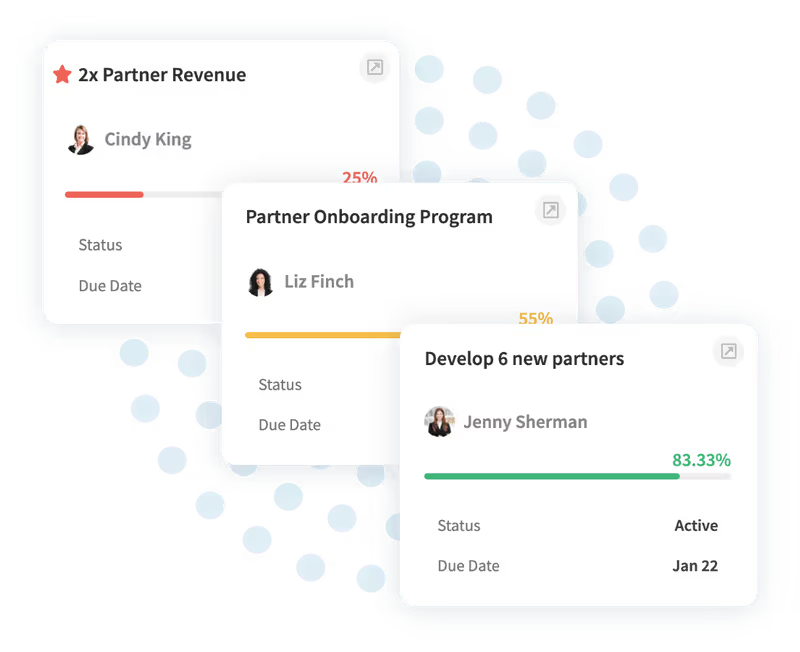What Do Performance Management Models Look Like in 2025?
Performance management models align an organization's goals with its employees' behaviors and efforts. The models drive feedback, celebrate achievements, motivate, and set expectations. They show employees where to focus their efforts. The processes also help employees understand their role within the organization.
What are the purposes of performance management models?
Performance management models provide a framework for managing, tracking, and rewarding performance. The formal process ensures employees get the feedback they need to improve their performance. Feedback can come in many different forms, but should always help employees grow and learn how to become more effective.
Feedback lets people know how they're doing on the job. Without this information, staff members may not understand what they're doing wrong. They may think everything is fine when it's not.
Feedback is most useful when it is timely. Imagine that your organization waits until annual reviews to assess an employee's job performance. In that case, even constructive criticism will come too late for anyone's benefit. Because the evaluation is too late to be beneficial, it can even cause resentment.
PerformYard is performance management software that can help you implement any performance management model. The platform offers continuous feedback functionality, making it easy to deliver timely feedback.
A performance management model can alsohelp you hire, develop, and reward employees. It also helps celebrate employee achievements.
Example: Your company has a sales goal for the year. One of your employees has been working hard towards that goal. You could give them a gift card or recognition certificate when they reach it.
This achievement will let them know they were able to do something great for your organization. Seeing others achieve success can also be very motivating for other employees.
Performance Management Models Examples
Performance management models come in various forms, each tailored to meet the unique needs of different organizational structures and goals. Below are some **performance management model examples** currently employed by leading companies, showcasing the diversity and adaptability of these models.
Example 1: General Electric (GE)
General Electric, a pioneer in the corporate world, has traditionally used a structured performance management model based on annual appraisals and performance ratings. However, in recent years, GE has shifted to a more contemporary framework that includes continuous feedback and agile goal setting.
- Annual Reviews: Traditionally, GE relied on yearly performance reviews for employees, which were subsequently replaced by continuous feedback mechanisms that offer real-time insights and personalized coaching.
- Agile Goal Setting: GE adopted a more flexible approach with agile goal setting, empowering employees to set, adjust, and achieve objectives in a dynamic work environment.
Example 2: Google
Google employs the OKR (Objectives and Key Results) framework, a well-known **performance management model example** that aligns employee objectives with the company's overarching goals.
- Quarterly OKRs: Google uses quarterly OKRs to set clear, measurable objectives for teams and individuals, promoting accountability and transparency.
- Continuous Feedback: Alongside the OKRs, Google has implemented a robust continuous feedback model, enabling real-time performance evaluations and fostering an open communication culture.
Example 3: Adobe
In 2012, Adobe discontinued its traditional annual performance reviews and introduced the Check-In process, a more flexible and engaging performance management model.
- Check-Ins: Adobe's Check-In model involves regular, informal conversations between employees and managers to discuss performance, feedback, and career development, ensuring continuous alignment and improvement.
- Peer Feedback: Adobe also values peer feedback as a critical component of its performance management model, allowing employees to provide and receive constructive input from colleagues.
Example 4: Microsoft
Microsoft has overhauled its performance management model to focus on growth mindset and frequent performance discussions, moving away from forced rankings and annual reviews.
- Growth Mindset: Microsoft fosters a culture of continuous learning by encouraging employees to adopt a growth mindset, focusing on personal and professional development.
- Frequent Performance Discussions: The company emphasizes regular one-on-one meetings between managers and employees, facilitating ongoing dialogue about performance, goals, and development opportunities.
These **performance management models examples** demonstrate the wide range of available approaches, from traditional frameworks to innovative, modern models. Each company tailors its performance management strategy to align with its unique culture, objectives, and workforce dynamics.
What are the different types of performance management models?
The best performance management model for your organization is a flexible one. It should adapt to your structure, goals, and culture.
Most performance management models fall into three categories.
- Traditional
- Modern
- Silicon Valley Approach
Each of these models can focus on accountability or development.
Traditional Performance Management Models
Traditional performance management models rely on annual and semi-annual check-ins. This type of performance management model has minimal touch points. The lack of touch points can hinder performance improvement. The traditional approach tends to look backward instead of forward, as employees and managers rarely meet.
Quarterly Check-Ins
Managers have a short meeting with employees every three months (or something similar). In this meeting, they’ll discuss what went well and what could improve in the next quarter. This is also a good time for both parties to upcoming projects that might need extra attention or support.

Annual Reviews
Once per year, the manager and employee will discuss the employee’s performance over the past twelve months. This annual review is a great time to set goals for the next year and develop a plan to reach those performance benchmarks.
Performance Ratings
Performance evaluations help motivate employees to perform at the highest level. The ratings help managers identify strengths and weaknesses. Rating models, such as those described in this article, give a numerical value to employee performance. Managers can use the ratings to reward employees or identify candidates for performance coaching.
Modern Performance Management Models
Modern performance management models offer a framework for improving employee performance. Traditional performance management relies on annual or quarterly reviews to identify deficiencies. The modern performance management model uses frequent touch points to help employees improve.
Continuous feedback
Consistent feedback creates an environment where people feel happy and appreciated at work. That kind of buy-in will also make it easier for your company to make changes or improvements down the line. Your team will be more likely to welcome new ideas if they already feel valued by management.
Continuous feedback is a great way to support your employees' professional growth. Rather than waiting for annual or quarterly reviews, you can offer timely feedback that can improve performance at any moment.

360 Reviews
You can build trust in a working relationship by having an open dialogue where people feel comfortable speaking their minds. Asking other employees for feedback on their team members can provide a holistic view of the employee's performance. 360 reviews build a well-rounded profile of an employee's performance.
1:1s
The 1:1 meeting is an important opportunity to foster a positive and productive relationship with employees. It's also a great time to get feedback on managerial performance, which can help managers improve.
The meeting should be a two-way conversation. Managers can talk about the things that are going well and how the employee can improve. The best way to do this is by talking about organizational goals:
- What does the organization want to achieve?
- What would success look like for the organization?
- How is the employee contributing toward this organizational goal?
The Silicon Valley Approach
Tech companies popularized the Silicon Valley approach. Intel developed it in the 1980s, and it has since been adopted by many other companies including Google, Facebook, Adobe, and .
The main advantage of this model is its simplicity. All you need is a list of monthly goals for each employee. The goals could be about improving customer satisfaction, process performance, or business performance. The only criterion for success is whether it helps the company grow over time.
OKRs
OKRs are a powerful component of the Silicon Valley approach. OKR stands for objectives and key results. The model provides a way of setting and tracking goals. Intel invented them, but some other successful companies use them too. At Google, OKRs are used to set objectives for each quarter and year. Google assesses the achievements at the end of each period.
The first step in setting OKRs is selecting your team's most important goal; the objective. The second step is to define key results that will help you achieve your objective. Break the objective down into smaller, more easily measurable, time-bound pieces.
Example: You want to improve company sales. A good objective would be: "Double our annual sales revenue by 2020." There are some guidelines for setting good objectives:
- Challenging but not impossible.
- Specific enough for others on your team to understand what you mean
- Measurable so you can track its progress over time
- Time-bound so you can set a target date of completion
After establishing an objective, teams must develop several key results. The company will use these results as benchmarks for achieving each goal. Each key result should align directly with one of these three questions:
- What do we want?
- Why do we want this?
- How do we measure success?

Example: You’re part of your company's marketing department. You’ve been tasked with helping double sales revenue by 2020. Your key results might look like this:
- “We will double our website traffic within six months"
- "Our lead generation campaign will increase conversion rates by 20% over three years."
Accountability-Based Performance Management Models
Accountability-based performance management models tend to be straightforward and uncomplicated. This doesn’t mean they’re the most effective. An accountability-based performance management model evaluates past performance.
This type of model can be beneficial because it gives employees a clear understanding of what is expected of them at work. However, accountability-based models don’t provide feedback that helps improve performance.
Development-Based Performance Management Models
Development-based performance management models focus on employee growth. The model is designed to help employees improve their skills and capabilities. Managers are responsible for evaluating their direct reports based on how they’ve improved over time.

For example, let's say that you're working in an IT department and your manager has given you access to a new tool for managing your projects. The first time she gives it to you, she tracks how long it takes you to learn how to use it. This will help her evaluate whether or not her teaching methods were effective.
PerformYard lets companies set employee development goals and track progress in one place.
What are the key features of performance management models?
The best performance management models offer flexibility and functionality. Your company's performance management model should help you answer questions like:
- Are we meeting our strategic goals?
- If not, why? And how can we fix it?
PerformYard is a performance management software that can simplify the employee review process. The platform works whether your company uses a traditional model, a modern model, or OKRs.
Simplicity and accessibility keep managers and employees engaged in performance management. PerformYard’s flexibility ensures that you can adjust the process. Each adjustment will help you get total buy-in from every member of your organization.


.jpg)

.jpg)
